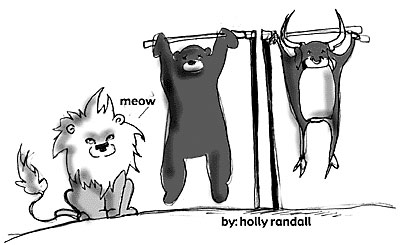


|

Illustration by Holly Randall
|
|
Arizona Daily Wildcat
Wednesday, September 8, 2004
Print this
Things you always never wanted to know
The Minoans of ancient Crete, around 2000 B.C., had surprisingly advanced plumbing. Well-engineered drain systems, supply pipes and a flush toilet were found in the palace of Knossos when it was excavated in 1899.
A woodchuck breathes only 10 times per hour while hibernating. An active woodchuck breathes 2,100 times an hour.
The Chinese, during the reign of Kublai Khan, used lions on hunting expeditions. They trained the big cats to pursue and drag down massive animals from wild bulls to bears and to stay with the kill until the hunters arrived.
Grains of sand are rounded by the action of the wind, which causes abrasion by blowing the sand particles against each other and surrounding obstacles. Once a grain reaches an almost perfectly spherical shape, it may keep that shape without further wear for millions of years.
Irving Berlin originally wrote his patriotic masterpiece, "God Bless America," for the Ziegfeld Follies. But after finishing it, he withdrew the song because he decided it didn't belong in a lavish girl show. It was not publicly performed until 20 years later, when Kate Smith introduced it, on the radio, on Armistice Day 1938.
A neutron star consists of matter so compressed that subatomic particles, chiefly neutrons, are in actual contact. If the sun were squeezed into a neutron star, it would be around 8 miles across instead of 865,400 miles across. A 1-pound object placed on the surface of a neutron star would weigh 20 trillion pounds.
Jimmy Carter was the first U.S. president to be born in a hospital.
Alexandre Gustave Eiffel, the man who designed the Eiffel Tower, also designed the inner structure of the Statue of Liberty in New York Harbor.
The famous 19th century bullfighter Lagartijo (born Rafael Molina) killed 4,867 bulls.
The Pacific Ocean encloses an area larger than all the land surfaces of the earth put together.
Garter snakes, though reptiles, do not lay their eggs. They bear live young, just as mammals do.
A bridge built in Lima, Peru, in 1610 was made of mortar that was not mixed with water but with the whites of 10,000 eggs! The bridge, appropriately called the Bridge of Eggs, is still standing.
Write a Letter to the Editor
|
|

|
